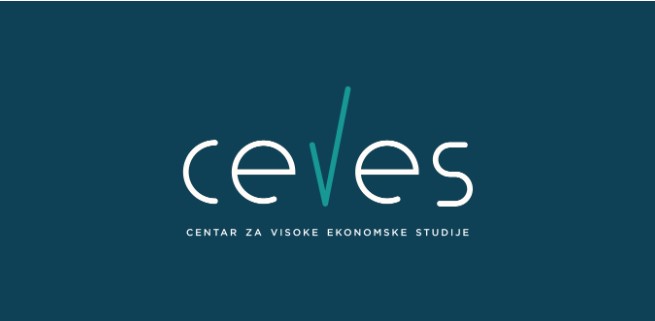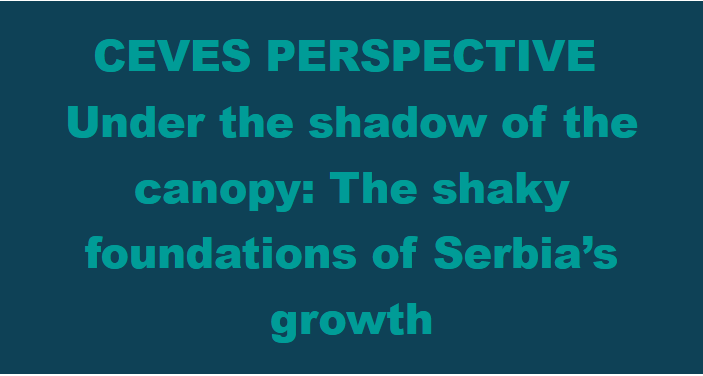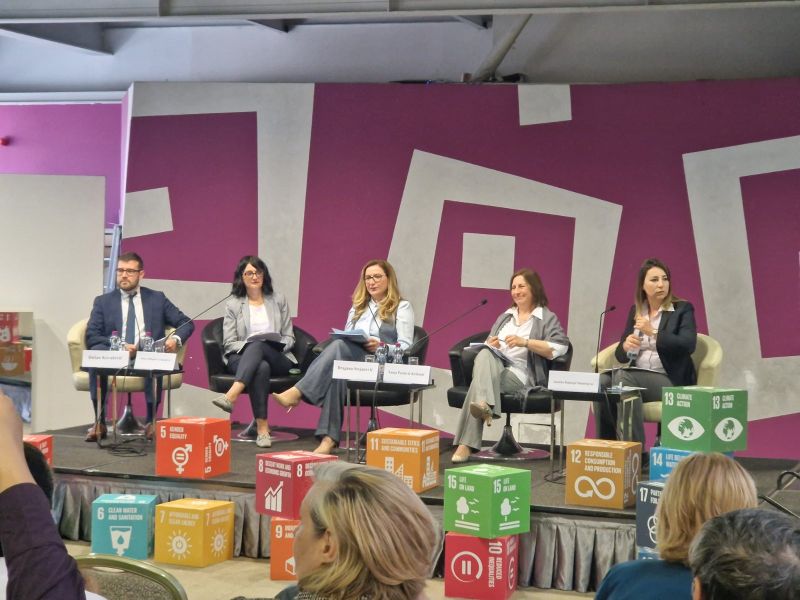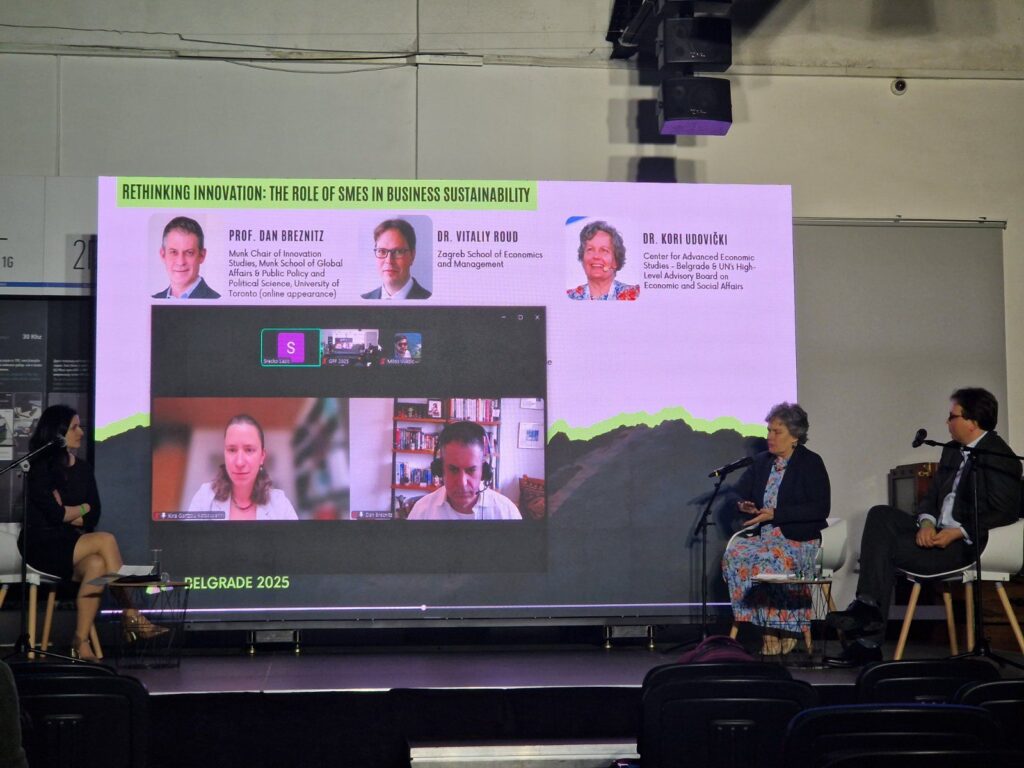We share with you our newsletter for the first quarter of 2025 – which, in addition to a brief overview of the most important economic trends in Serbia and the EU, also provides our reflections on the key challenges shaping the economic and political climate, as well as CEVES’ activities during this period.
The past quarter saw Serbia’s economy slow its growth, with global economic policy uncertainties and possibly a domestic political crisis beginning to spill over into economic sentiment. In the “CEVES Perspective” section, we address signs that institutional weaknesses (rather than protests) have started visibly hindering economic growth (unlike sustainable development, which they have been obstructing for some time).
According to flash estimates, Serbia’s GDP growth significantly slowed in Q1 2025 (2% vs. 3.9% in 2024), primarily due to a continued slowdown in both public and private investments that began in the second half of 2024, as well as a further decline in goods exports to Western markets. Although direct data is not yet available, this is inferred from a sharp decline (-55%) in foreign direct investments in the first quarter of this year and a drop in the state’s capital expenditures (-8%) throughout the quarter compared to the same period last year. The value of exports of ICT and other creative services, as well as ores and base metals, continued the strong growth from the previous period, likely explaining why growth still remained positive.
Change in the export structure is reflected in the growth of exports from the mining and base metals sectors (+16%), alongside a simultaneous decline in exports from industries involved in global value chains, such as the automotive industry and related sectors, as well as those relying on low labor costs (-20%). Service exports, led by ICT, recorded real growth and made a significant positive contribution. Domestic consumption remained the only stable component: public consumption grew slightly in real terms, while private consumption likely began to weaken, as indicated by a decline in domestic tourist overnight stays, lower VAT collection, and stagnation in retail.
Economic sentiment in Serbia at the beginning of 2025 fell below 100, aligning with the EU27 average, primarily due to a sharp decline in sentiment in the services sector – one of the lowest since the pandemic (although, unlike then, it is still above 100 now). Sentiment in the industrial and construction sectors shifted from slightly positive to negative, with a much sharper decline in construction. This is reflected in official data – the value of construction works in Q1 2025 fell by 1.4% in current prices and 5.6% in constant prices. Meanwhile, sentiment in retail remains relatively stable and positive, though negative consumer sentiment has somewhat deepened. The decline in Serbia’s sentiment occurs in the context of broader European stagnation – sentiment in the EU27 remains slightly negative and largely unchanged despite falling interest rates, while in Germany, our most important trading partner, which ended 2024 with a decline in economic activity, sentiment is at one of its lowest levels since the pandemic.
Protests were certainly not the main culprit for the slowdown in economic growth in the first quarter of this year, but they exposed the fact that Serbia’s economic growth in recent years has rested on increasingly fragile foundations. It is normal for economic growth in a country to slow when public investments fall by 8%. But it is not normal for public investments to fall because, in the words of President Aleksandar Vučić, “there isn’t a damn soul who will sign any paper.” In fact, it was never normal that “damned souls” in Serbia signed papers at all – they did so because the President urged and pushed them through parallel channels of power built precisely to bypass institutions.
The infrastructure built this way has begun to crumble, as have the foundations on which such growth was based. The easy wins offered by Serbia’s eroded economic potential during the transition have been exhausted. Irresponsible construction, we hope, will no longer be tolerated by Serbia’s engineers. For further sustainable growth, and especially development, institutions must enable legal certainty and productivity growth by listening to the needs of the economy.
This primarily involves eliminating discrimination against domestic businesses, measures to support their investments and modernization (digitalization and alignment with green transition requirements), and ensuring increasingly better and more relevant educational profiles – essential steps to replace investors who are now leaving with those who need knowledge and skills.
None of this is on the horizon.
Read the article further exploring this topic HERE.
Sustainable and resilient communities start locally
At the closing conference of the “Sustainable development for all” project, held on April 4 in Belgrade, CEVES organized a panel discussion titled “Planning the development of sustainable, inclusive, and resilient communities.” Participants from various sectors – local governments, development agencies, and civil society – highlighted the key role of local actors in achieving sustainable development goals.
The discussion shed light on the barriers communities face in a centralized system – such as lack of autonomy, limited capacities, and poor communication with local economy – but also pointed to the potential of inter-municipal cooperation and good practices, such as the “Green-blue communities” project and CEVES’ SME100 initiative, which demonstrate how concrete policies can be developed from the ground up, empowering local businesses and fostering dialogue with the community.
The panel’s conclusion was clear: genuine sustainable development requires meaningful decentralization and systemic support for local initiatives.
SMEs in the focus of sustainable development at the Green Peak Festival
CEVES was a partner of the first Belgrade edition of the Green Peak Festival – Austria’s largest conference dedicated to sustainability – held on April 3. As a long-time advocate for the importance of small and medium enterprises (SMEs) for sustainable and inclusive growth, CEVES premiered a short film showcasing the best examples of innovative and successful Serbian SMEs. The film was designed to highlight their contribution to sustainability and business resilience and is available HERE.
During the conference, CEVES’ president and director, Kori Udovički, participated in a panel discussion created, organized, and moderated by Sonja Avlijaš from the Faculty of Economics at the University of Belgrade, titled “Rethinking innovation: The role of SMEs in business sustainability.” Kori Udovički emphasized that Serbian SMEs, especially exporters, are deeply rooted in their local communities and highly innovative, as this is the only way they can survive, a view shared by the other panelists.
CEVES at the panel on Serbia’s development challenges
Organized by The Serbian Academy of Sciences and Arts, the World Bank, and CEVES, a panel discussion titled “Is Serbia trapped in the middle-income trap?” was held to present the World Bank’s report Greater heights: Growing to high income in Europe and Central Asia.
The key findings were presented by Dr. Ivailo Izvorski, Chief Economist for Europe and Central Asia at the World Bank, with participation from academic Pavle Petrović, Dr. Milojko Arsić, Dr. Kori Udovički, and Dr. Nicola Pontara.
The panelists agreed that domestic private investments remain low, and Serbia’s growth continues to rely on foreign investments and public consumption.
CEVES particularly highlighted that Serbian SMEs rarely grow into large companies – despite examples like SME100 showing high potential for innovation, exports, and growth. For these companies to become the backbone of sustainable development, deeper institutional and policy reforms are needed to support their growth beyond the SME framework.
The report is available at: Greater heights: Growing to high income in Europe and Central Asia.
Is Serbian economy suffering from Dutch disease?
An introduction to the analysis of the need for a new economic policy
In early June 2025, CEVES will organize a roundtable with leading economic experts in Serbia to open an evidence-based discussion on whether the Serbian economy could be diagnosed with a specific form of Dutch disease. This will be the first in a series of roundtables aimed at recommending economic reforms and policies to enhance Serbia’s competitiveness, supporting citizens striving for the establishment of the rule of law and accountable institutions.
Partnerships and cooperation for development
CEVES has started a new project with the International Labour Organization (ILO) to explore how climate change affects employment in Serbia and identify policies that promote a just transition to green jobs.
CEVES has also begun a market assessment for factoring in the Western Balkans for the International Finance Corporation (IFC), aiming to identify barriers and opportunities for developing this financial instrument to support the growth of small and medium enterprises in the region.
Thank you for following our work and contributing to the dialogue on sustainable and just development in Serbia!
Your CEVES team








 SR
SR